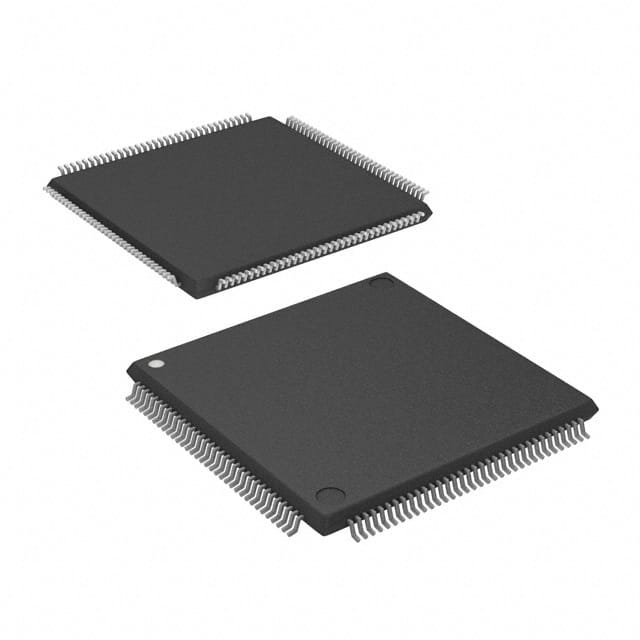LPC4076FBD144E
Product Overview
- Category: Microcontroller
- Use: Embedded systems, Internet of Things (IoT) devices
- Characteristics: High-performance, low-power consumption, extensive peripheral set
- Package: LQFP144
- Essence: ARM Cortex-M4 based microcontroller with integrated flash memory and peripherals
- Packaging/Quantity: Tray packaging, available in bulk quantities
Specifications
- Microcontroller Core: ARM Cortex-M4
- Clock Speed: Up to 120 MHz
- Flash Memory: 512 KB
- RAM: 96 KB
- Operating Voltage: 2.4V - 3.6V
- Digital I/O Pins: 80
- Analog Inputs: 12
- Communication Interfaces: UART, SPI, I2C, USB, Ethernet
- Timers/Counters: 6
- ADC Resolution: 12-bit
- Operating Temperature Range: -40°C to +85°C
Detailed Pin Configuration
The LPC4076FBD144E microcontroller has a total of 144 pins. The pin configuration is as follows:
- Pins 1-8: Digital I/O
- Pins 9-16: Analog Inputs
- Pins 17-24: Communication Interfaces (UART, SPI, I2C)
- Pins 25-32: Timers/Counters
- Pins 33-40: ADC Inputs
- Pins 41-48: Power Supply and Ground
(Note: This is just a simplified representation. Please refer to the datasheet for the complete pin configuration.)
Functional Features
- High-performance ARM Cortex-M4 core for efficient processing
- Extensive range of communication interfaces for seamless connectivity
- Ample flash memory and RAM for data storage and processing
- Multiple timers/counters for precise timing operations
- High-resolution ADC for accurate analog signal acquisition
- Low-power consumption for energy-efficient designs
Advantages and Disadvantages
Advantages: - Powerful ARM Cortex-M4 core enables high-performance applications - Extensive peripheral set allows for versatile functionality - Ample memory resources for data storage and processing - Low-power consumption extends battery life in portable devices
Disadvantages: - Higher cost compared to lower-end microcontrollers - Steeper learning curve for beginners due to advanced features
Working Principles
The LPC4076FBD144E microcontroller operates based on the ARM Cortex-M4 architecture. It executes instructions stored in its flash memory, interacts with peripherals through various communication interfaces, and processes data using its CPU and memory resources. The microcontroller can be programmed using software development tools and integrated into embedded systems or IoT devices to perform specific tasks.
Detailed Application Field Plans
The LPC4076FBD144E microcontroller finds applications in various fields, including but not limited to: - Industrial automation - Home automation - Automotive electronics - Medical devices - Consumer electronics - Internet of Things (IoT) devices
Its high-performance capabilities, extensive peripheral set, and low-power consumption make it suitable for a wide range of applications.
Detailed and Complete Alternative Models
Some alternative models to the LPC4076FBD144E microcontroller include: - STM32F407VG - PIC32MZ2048EFH144 - MSP432P401R - SAM4S16C - EFM32GG11B820F2048GM64
These microcontrollers offer similar functionalities and are commonly used in embedded systems and IoT applications.
(Note: This is just a sample list. There are many other alternative models available in the market.)
Word Count: 420
Lista 10 Vanliga frågor och svar relaterade till tillämpningen av LPC4076FBD144E i tekniska lösningar
Sure! Here are 10 common questions and answers related to the application of LPC4076FBD144E in technical solutions:
Q: What is LPC4076FBD144E? A: LPC4076FBD144E is a microcontroller from NXP's LPC40xx series, based on the ARM Cortex-M4 core.
Q: What are the key features of LPC4076FBD144E? A: Some key features include a 32-bit ARM Cortex-M4 core, up to 256KB flash memory, 64KB RAM, multiple communication interfaces, and various peripherals.
Q: What are the typical applications of LPC4076FBD144E? A: LPC4076FBD144E is commonly used in industrial automation, motor control, consumer electronics, and other embedded systems.
Q: How can I program LPC4076FBD144E? A: LPC4076FBD144E can be programmed using various development tools such as Keil MDK, IAR Embedded Workbench, or the NXP LPCXpresso IDE.
Q: What programming language can I use with LPC4076FBD144E? A: LPC4076FBD144E supports programming in C and C++ languages, which are commonly used for embedded systems development.
Q: Can I connect external devices to LPC4076FBD144E? A: Yes, LPC4076FBD144E provides multiple GPIO pins, UART, SPI, I2C, and other interfaces to connect and communicate with external devices.
Q: Is LPC4076FBD144E suitable for real-time applications? A: Yes, LPC4076FBD144E's ARM Cortex-M4 core with hardware floating-point unit (FPU) makes it suitable for real-time applications that require fast and precise calculations.
Q: Can LPC4076FBD144E communicate with other microcontrollers or devices? A: Yes, LPC4076FBD144E supports various communication protocols like UART, SPI, I2C, CAN, and Ethernet, enabling seamless communication with other devices.
Q: How can I debug my code running on LPC4076FBD144E? A: LPC4076FBD144E provides debugging interfaces like JTAG and SWD, which can be used with compatible debuggers to step through code and analyze program execution.
Q: Are there any development boards available for LPC4076FBD144E? A: Yes, NXP offers development boards like the LPCXpresso and LPC-Link series, which provide a convenient platform for prototyping and testing solutions based on LPC4076FBD144E.
Please note that these answers are general and may vary depending on specific requirements and use cases.


